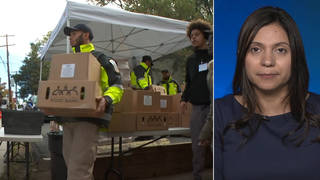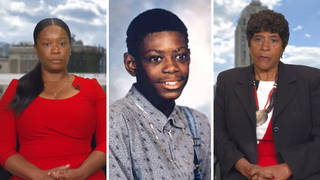
Guests
- Kimberlé Crenshawlaw professor at UCLA and Columbia University and the founder of the African American Policy Forum.
- Candace Ligerco-founder of OKC Artists for Justice, an Oklahoma City-based advocacy group founded around the Holtzclaw case.
- Grace Franklinco-founder of OKC Artists for Justice, an Oklahoma City-based advocacy group founded around the Holtzclaw case.
A former Oklahoma City police officer is facing life in prison for the serial rapes of African-American women. An all-white jury convicted Daniel Holtzclaw last week of rape and other crimes against eight of the 13 women who accused him. All 13 victims testified during the trial, each with similar stories of rape, sexual assault, and threats if they did not comply with Holtzclaw’s demands. Holtzclaw targeted them during traffic stops and interrogations, forcing them into sexual acts in his police car or in their homes. Prosecutors say he deliberately preyed on vulnerable black women from low-income neighborhoods. He was reportedly under investigation by the Oklahoma City police sex crimes unit six weeks before his final crime. That means Holtzclaw assaulted half of the women he was convicted of attacking while under investigation. While Holtzclaw’s conviction may bring his victims some relief, the case has raised questions about whether it’s part of a wider problem of devaluing African-American lives, in this case African-American women. Despite the charges and ultimate convictions of serial rape, the Holtzclaw prosecution got far less corporate media attention than other criminal trials. We hear from some of his victims and speak with three guests: Kimberlé Crenshaw, law professor at UCLA and Columbia University and the founder of the African American Policy Forum; and Candace Liger and Grace Franklin, co-founders of OKC Artists for Justice, an Oklahoma City-based advocacy group founded around the Holtzclaw case.
To see Part 2 of our conversation, click here.
Transcript
AMY GOODMAN: A former Oklahoma City police officer is facing life in prison for the serial rapes of African-American women. An all-white jury convicted Daniel Holtzclaw last week of rape and other crimes against eight of the 13 women who accused him. All 13 victims testified during the trial, each with similar stories of rape, sexual assault, threats if they didn’t comply with Holtzclaw’s demands. Holtzclaw targeted them during traffic stops and interrogations, forcing them into sexual acts in his police car or in their homes.
Prosecutors say Holtzclaw deliberately preyed on vulnerable black women from low-income neighborhoods. They ranged in age from 17 to 57. Most of the women said they didn’t go to the police because they didn’t think they could get justice. One said, quote, “I didn’t think anyone would believe me. I’m a black female.” But one woman did come forward to get the case rolling. It was Holtzclaw’s oldest victim, 57-year-old Jannie Ligons. At a news conference the day after the verdict, she spoke out.
JANNIE LIGONS: All I can say is, I was a victim. I was traumatized. I went to therapy. I had a stroke behind this. And I still live with this, day after day. And all I know is, I wasn’t a criminal. I have no record. I didn’t do anything wrong. You said I did something wrong. You said I was swerving, which I was not. You just wanted to stop me. So all I can say is, I was innocent, and he just picked the wrong lady to stop that night.
BENJAMIN CRUMP: Yes.
AMY GOODMAN: That’s Jannie Ligons, a victim, who reported Officer Daniel Holtzclaw to the police, where he worked.
The rapes happened between December 2013 and June 2014. Holtzclaw was reportedly under investigation by the Oklahoma City police sex crimes unit six weeks before his final crime. That means Holtzclaw assaulted half of the women he was convicted of attacking while under investigation. Holtzclaw broke down in tears as the verdicts were read last week, and prison officials say he is now on suicide watch.
While Holtzclaw’s conviction may bring his victims some relief, the case has raised questions about whether it’s part of a wider problem of devaluing African-American lives—in this case, African-American women. Despite the charges and ultimate convictions of serial rape, the Holtzclaw prosecution got far less corporate media attention than other criminal trials. And following a series of high-profile police killings and abuses of unarmed African-Americans, some have questioned whether Holtzclaw’s crimes were enabled by a criminal justice system that dehumanizes African Americans. In a variation of the movement slogan “Black Lives Matter,” some who attended the Holtzclaw trial have been saying, “Black Women Matter.”
We’re joined now by three guests. Kimberlé Crenshaw is with us, a law professor at UCLA and Columbia University and the founder of the African American Policy Forum. And in Oklahoma City, Candace Liger and Grace Franklin are the co-founders of OKC Artists for Justice, an Oklahoma City-based advocacy group founded around the case of Officer Daniel Holtzclaw.
Let’s go to Oklahoma City first. Candace, let’s begin with you. Talk about this case. We’re talking about rapes and sexual assaults that happened, what, two years ago, two and one-and-a-half years ago. The trial just took place. Why did you get involved? What do you think are the key issues here?
CANDACE LIGER: I think the key issues really revolve around the abuse of power. On the northeast side, there are many different—different type of areas, socioeconomic-wise. And Holtzclaw specifically preyed on women in the lower-income, impoverished areas of the African-American community. So we, as African-American women familiar with the Eastside, we wanted to make sure that we gave these women a voice, not only in the judicial system, but also show that there is a community that backs their claims, that believes these women. And I think that’s really important, especially involving sexual assault cases where they were constantly under attack, as far as their character, as far as their history, their past, their past criminal records. So, regardless of that, we wanted to show that we believe you.
AMY GOODMAN: Grace Franklin, you were particularly focused on, among other issues, the issue of bail. Explain how Holtzclaw got caught, how he went on for so long. We’re just talking about a particular set of rapes and assaults. Who knows how many others he was involved with? How long was he an officer. This Guardian piece that says he was under investigation as he committed crime after crime.
GRACE FRANKLIN: Well, initially, with the bail, the bail issue, the reason this case came to light was because of Ms. Ligons, that you just heard from, the 57-year-old grandmother who reported. She was the first survivor to report. And then, once he was arrested, the initial bail was set at $5 million. So that is a statement, and that is a way to keep a defendant in jail, because he wasn’t going to be able to come up with that type of money to get out. Another judge came in, Judge Timothy Henderson, the same judge who was over the proceedings for the trial, and reduced it to $500,000. When that occurred, what we knew was that was about the value of black women. We believe there’s no way if 13 white women, Asian women, Hispanic women—any other group of women—if it were 13 of them, there’s no way it would go from $5 million to $500,000.
The other issue with bail is that he was on a home monitoring system. He violated the home monitoring system, because he went to a doctor’s appointment without notification. He spent 14 days in jail and then was allowed to put—be back on a monitoring system at home. That’s unheard of. You cannot violate a home bail, you cannot violate a home monitoring system, and be put back on it. That’s unheard of.
And then, in the end, the way he was remanded to jail is that the bond company revoked his bail. And that’s how he was back in prison or in jail, remanded in August of 2015. So those things that happened is a clear reflection of us, that black women aren’t as valued. There is no way that it would go from $5 million to $500,000, that he would violate home monitoring system and then still be out. We believe that that is a reflection of how black women are viewed in this country and how, in the justice system, they are not valued.
AMY GOODMAN: I want to turn to Sharday Hill, one of the women who pressed charges against Officer Daniel Holtzclaw. She recounted what happened after he arrested her and took her to a hospital, where her clothes were taken away and she was handcuffed to the bed.
SHARDAY HILL: Me being in a room with the police, not expecting to get violated the way I did, the way I was done, I just couldn’t even believe it. I just—I couldn’t even—I was speechless. I was scared. I didn’t—when everything was going down, I just—I felt—I mean, I was scared. I didn’t know what to do. I felt like I was in survivor mode, so I had to do what he was making me do. So—
BENJAMIN CRUMP: That’s fine. That’s fine, that’s fine. Thank you.
AMY GOODMAN: That was Sharday Hill, one of Holtzclaw’s victims. Speaking one day after the verdict was announced, lawyer Benjamin Crump, who represented five of the women against Officer Holtzclaw, called his clients Jannie Ligons and Sharday Hill “heroes.”
BENJAMIN CRUMP: The biggest hero here, the biggest hero here, and I hold her hand up in victory, because she’s a survivor. She is a survivor. Sharday is a survivor. This is a victorious time. And we’re not celebrating just because what happened in court. We’re celebrating their courage to come and tell the story for so many other women who never came forward after they suffered as victims of rape, of domestic violence, of abuse, where this is the face of courage, when people dare to stand up and say, “We refuse to remain silent.” So we applaud you all. We thank you all. America thanks you all.
AMY GOODMAN: That’s attorney Benjamin Crump. Professor Kimberlé Crenshaw, talk about your involvement with the case, and talk about these women heroes who came forward.
KIMBERLÉ CRENSHAW: Yes. Well, Amy, this is precisely an example of the vulnerability that black women face to various forms of police abuse. We wrote about this in a report called “Say Her Name,” including sexual abuse of police officers as one of the particular ways that black women experience police abuse, but also one of the ways that police abuse is not included in the way we’ve been mobilizing around violence against black bodies. So, these are examples of what happens when police have the authority, unchecked discretion, the belief that whatever they’re doing is generally legitimate. What happens is that those who are marginalized, both because of their race, their gender, where they live, their criminal background—all of these are the things that make these women more vulnerable, because they’re less likely to be believed, what happens to them doesn’t matter.
And quite frankly, as you mentioned earlier, the corporate media doesn’t pay any attention to these issues at all. So if we were to think about, for example, what would have happened if a security guard or a campus police officer had raped 13 women on a college campus, or a coach had done the same thing, that courtroom would have been packed. We would have known everything about what happens to young women in college campuses. So we really have to ask ourselves: How could this have happened with so little attention to these cases?
AMY GOODMAN: The lawyer, Benjamin Crump, also raised this issue of where was the media surrounding this case.
BENJAMIN CRUMP: I scratched my head after [inaudible] and said, what is it about these 13 women that is problematic or troubling? What is it about them? What is it—why are they unworthy of national media attention in such a sensational situation as a serial rapist with a badge raping a dozen of women? What is it about them? Aren’t they American citizens? Don’t they have civil rights? More importantly, don’t they have human rights?
AMY GOODMAN: That’s lawyer Benjamin Crump, who represented five of the victims. He was surrounded by some of those women, the women he called heroes. Now, Professor Crenshaw, there were 13 women who testified. In only eight of the cases was he found guilty.
KIMBERLÉ CRENSHAW: That’s right.
AMY GOODMAN: What happened? And what happens to these women who testify and they don’t find him guilty in those cases?
KIMBERLÉ CRENSHAW: So, and one of the women whose testimony apparently wasn’t believed was the one who was handcuffed to a hospital bed when the actual assault occurred. So, it’s absolutely mind-boggling, in part because—
AMY GOODMAN: That was Sharday?
KIMBERLÉ CRENSHAW: Yeah—well, yes. And part of what’s so surprising about it is that there is a—the statute actually says that individuals who are assaulted in custody, when an officer has control over them, supposedly that is a second-degree rape charge. So, we can only speculate that there are aspects of their character that the jury credited in deciding that some of these women would not be believed.
But it’s important to understand this within a broader historical context. If we look at rape overall, black women are the least likely to be believed. Their cases are the most likely to be thrown out. And when there is a conviction, on the rare occasion that that happens, their assailants get the least number of years.
So, we start with just the fact that black women are generally not believed. You add to that that those victims who have particular kind of backgrounds are also less likely to be believed. You put those two things together, and it becomes a textbook example of what happens to black women, poor black women, poor black women in neighborhoods where generally their expectation of privacy is lessened.
AMY GOODMAN: Now, some of these women were prisoners, meaning they were brought into the court to testify—is this true, Grace Franklin—in orange jumpsuits, and they were handcuffed? This is how they appeared before the jury?
GRACE FRANKLIN: Yes. There were two of the survivors who were in custody, in jail, at the time of the trial. So when they came in to testify, they came in in orange jumpsuits and shackled. That is how they came in the court. That is how they testified on the stand. And we believe that’s part of the issue with their convictions, why some of those convictions were not guilty. You have those women, these survivors, on the stand looking as if they are prisoners, and the defendant is at the table with a wonderfully tailored suit on. That is one of the biggest issues in this trial for us as advocates for sexual survivors, because that definitely will sway the jury in what type of women they are. So, you have this woman testifying against a former police officer, but she’s in shackles, she’s in jail, she has the orange jumpsuit on. So she is the criminal, and somehow he is the victim. So it totally changes the perspective of the jury.
AMY GOODMAN: Oklahoma has twice as many women in prison as in other states? It’s been called the female incarceration capital of the United States, Professor Crenshaw?
KIMBERLÉ CRENSHAW: Yes, and this is one of the reasons why their vulnerability is connected to criminalization, and why we have to talk about rape when we’re talking about mass incarceration and police abuse. It is precisely because so many of them were involved in the criminal justice system, knew that they couldn’t trust the police, knew that if they were to be arrested, the chances that they would actually face additional charges were great. So these things come together. When a group is criminalized, they’re also vulnerable to other kinds of misconduct and abuse.
AMY GOODMAN: Candace Liger, what sentence does Officer Crenshaw [sic] face, now that he’s been convicted in eight of the cases?
CANDACE LIGER: Officer Holtzclaw?
AMY GOODMAN: Yes.
CANDACE LIGER: I’m sorry. Can you repeat the question? I’m sorry.
AMY GOODMAN: Yes. What’s the sentence?
CANDACE LIGER: So, he was convicted of 18 of the 36 counts. The total sentence added up to 263 years. So, the recommendation by the jury was that that sentence would be served consecutively. I think now, at this point, we want to make sure that that sentence is actually served consecutively, when the sentencing date occurs. And that takes place January 21st. At that time, the judge can decide if it’s going to be consecutive or concurrent. Concurrent would mean he would serve all of his time at once. So, since the maximum sentence was 30 years, he would serve approximately 85 percent of that, which would be about 28-and-a-half years.
AMY GOODMAN: I want to thank you all for being with us, Candace Liger and Grace Franklin, co-founders of OKC Artists for Justice in Oklahoma City, and Professor Kimberlé Crenshaw, law professor at UCLA and Columbia. We’re going to continue this discussion, and we’ll post it online at democracynow.org.












Media Options